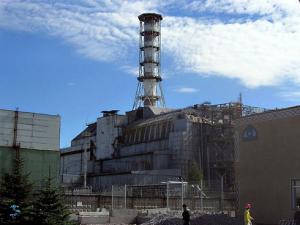Nuclear accidentsRisk of another Chernobyl- or Fukushima-type accident worryingly plausible
The biggest-ever statistical analysis of historical nuclear accidents suggests that nuclear power is an underappreciated extreme risk and that major changes will be needed to prevent future disasters. The researchers’worrying conclusion is that, while nuclear accidents have substantially decreased in frequency, this has been accomplished by the suppression of moderate-to-large events. They estimate that Fukushima- and Chernobyl-scale disasters are still more likely than not once or twice per century, and that accidents on the scale of the 1979 meltdown at Three Mile Island (a damage cost of about $10 billion) are more likely than not to occur every 10-20 years.

Chernobyl plant showing destruction resulting from core meltdown // Source: commons.wikimedia.org
A team of risk experts who have carried out the biggest-ever analysis of nuclear accidents warn that the next disaster on the scale of Chernobyl or Fukushima may happen much sooner than the public realizes.
Researchers at the University of Sussex, in England, and ETH Zurich, in Switzerland, have analyzed more than 200 nuclear accidents, and — estimating and controlling for effects of industry responses to previous disasters — provide a grim assessment of the risk of nuclear power.
U Sussex reports that their worrying conclusion is that, while nuclear accidents have substantially decreased in frequency, this has been accomplished by the suppression of moderate-to-large events. They estimate that Fukushima- and Chernobyl-scale disasters are still more likely than not once or twice per century, and that accidents on the scale of the 1979 meltdown at Three Mile Island (a damage cost of about $10 billion) are more likely than not to occur every 10-20 years.
As Dr. Spencer Wheatley, the lead author, explains: “We have found that the risk level for nuclear power is extremely high.
“Although we were able to detect the positive impact of the industry responses to accidents such as Three Mile Island and Chernobyl, these did not sufficiently remove the possibility of extreme disasters such as Fukushima. To remove such a possibility would likely require enormous changes to the current fleet of reactors, which is predominantly second-generation technology.”
The studies, published in two papers in the journals Energy Research & Social Science and Risk Analysis, put fresh pressure on the nuclear industry to be more transparent with data on incidents.
“Flawed and woefully incomplete” public data from the nuclear industry is leading to an over-confident attitude to risk, the study warns. The research team points to the fact that their own independent analysis contains three times as much data as that provided publicly by the industry itself. This is probably because the International Atomic Energy Agency, which compiles the reports, has a dual role of regulating the sector and promoting it.
The research team for this new study gathered their data from reports, academic papers, press releases, public documents and newspaper articles. The result is a dataset that is unprecedented — being twice the size of the next largest independent analysis. Further, the authors emphasize that the dataset is an important resource that needs to be continually developed and shared with the public.
